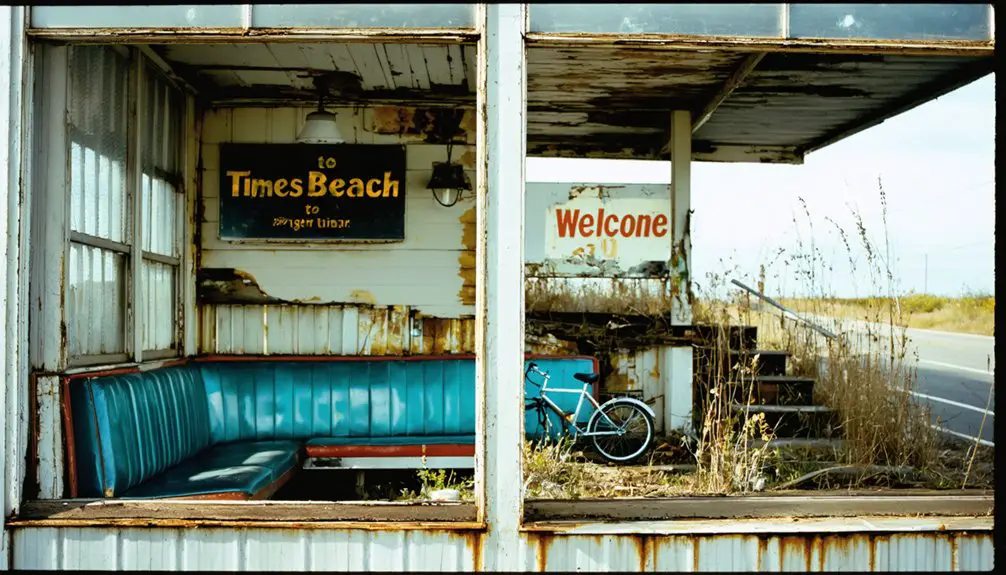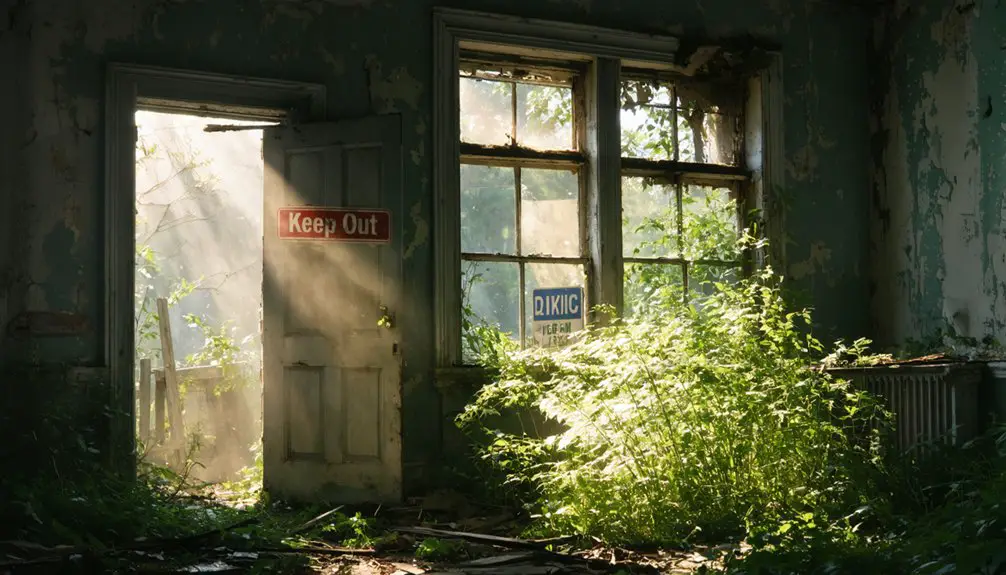You’ll find Times Beach’s tragic transformation from riverside resort to ghost town deeply rooted in environmental negligence. In 1982, severe flooding mixed with dioxin-contaminated roads, forcing the permanent evacuation of 2,000 residents. The $36.7 million federal buyout and subsequent $200 million cleanup marked one of America’s worst environmental disasters. Today, the former toxic site exists as Route 66 State Park, where nature’s resilience tells a cautionary tale of human impact on local ecosystems.
Key Takeaways
- Times Beach became a ghost town in 1983 after the EPA evacuated over 2,000 residents due to severe dioxin contamination.
- The town’s abandonment resulted from toxic oil sprayed on roads mixing with catastrophic flooding in December 1982.
- The federal government spent $36.7 million buying out residents and demolishing approximately 700 buildings in Times Beach.
- A massive cleanup operation destroyed 265,000 tons of contaminated materials using a specialized incinerator between 1995-1997.
- The former ghost town site is now Route 66 State Park, a 424-acre natural sanctuary featuring wildlife and historic exhibits.
The Birth of a River Resort Town
When the St. Louis Star-Times newspaper launched its 1925 promotion offering riverside lots for $67.50 with a subscription, they unknowingly sparked the creation of a unique river tourism destination.
Times Beach emerged on the Meramec River‘s floodplain as a strategic escape for St. Louis residents seeking refuge from urban life.
You’ll find the town’s early environmental adaptation reflected in homes built on stilts, acknowledging nature’s seasonal rhythms rather than fighting them.
The 1932 Meramec River bridge and Route 66’s arrival transformed accessibility, drawing more seasonal residents to this waterfront haven.
The Steinys Inn opened in 1935, becoming a popular establishment for travelers and locals alike.
The town’s ecological footprint remained relatively light during its resort years, with businesses like Sylvan Beach and Bridgehead Inn harmonizing with the natural landscape.
This delicate balance between human leisure and riverfront ecology defined Times Beach‘s early character.
By 1970, the area had transitioned from a summer resort destination into primarily low-income housing.
Life Along the Meramec Floodplain
Living along the Meramec floodplain, you’d find yourself in a constant dance with the river’s unpredictable nature, as your daily routines adapted to the ebb and flow of waters that could rise with little warning.
You’d witness how repeated flooding events shaped not just the physical landscape but also forged tight-knit bonds among residents who learned to support each other through evacuations and recovery efforts.
Since 2015, the area has experienced three record floods, dramatically altering how communities prepare for and respond to rising waters.
As rainfall patterns intensified and development reduced natural flood buffers, you’d see your community developing increasingly sophisticated strategies to cope with the rising waters, from improved emergency communications to coordinated flood response plans.
The river basin’s location within the Ozark Highlands ecoregion created a unique blend of natural beauty and environmental challenges that residents had to navigate.
River Life Daily Challenges
Life along the Meramec River floodplain presented residents with persistent hydrological challenges, as severe flooding became increasingly frequent due to a 35% rise in rainfall and 20% higher stream flows.
You’ll find your daily routines constantly disrupted by inundated roads and bridges, while the river ecosystem struggles to maintain its natural balance against urban development pressures.
Your flood management efforts are complicated by limited real-time information and aging infrastructure that can’t keep up with the changing hydrology.
If you’re living in lower-income areas, you’re particularly vulnerable to these impacts.
The loss of wetlands and open spaces has reduced nature’s ability to protect you from flooding, while increasing runoff and pollutants affect both your property and the surrounding environment.
Floods Shape Community Spirit
These persistent challenges along the Meramec River have forged an unshakeable community spirit, particularly evident during major floods in 1982, 2015, and 2017.
You’ll find that flood resilience strategies have evolved from reactive measures to proactive solutions, as demonstrated by Valley Park’s protective levee system.
While some communities face tough choices about relocation, others have implemented community rebuilding efforts that strengthen their connection to the river. The Red Cross shelters provided crucial temporary housing for displaced residents during both major flood events.
The absence of flood control dams has left many riverside communities vulnerable to recurring flooding.
You’re witnessing a transformation in how riverside residents adapt to nature’s power.
The Times Beach environmental disaster taught valuable lessons about human-river relationships, leading to improved flood management practices.
Today, you’ll see communities balancing development with environmental respect, creating new approaches to living alongside the Meramec’s unpredictable waters.
Adapting Through Rising Waters
As floodwaters continue reshaping the Meramec River’s landscape, residents and municipalities have developed sophisticated adaptation strategies to cope with intensifying flood risks.
You’ll find communities embracing floodplain restoration initiatives while balancing development needs with natural flood protection.
You’re witnessing a transformation in how people live with the river. Modern flood inundation mapping systems help you track rising waters in real-time, while multi-jurisdictional management plans strengthen community resilience.
With rainfall intensity up 35% during the wettest days, you’re seeing innovative responses – from preserving wetlands to implementing smarter zoning laws.
The river’s changing patterns haven’t defeated local spirit. Instead, you’re part of a growing movement that’s learning to adapt, combining technology with nature-based solutions to protect both property and ecological systems.
The Fatal Mix: Floods and Toxic Roads
When the Meramec River’s floodwaters engulfed Times Beach in December 1982, they released more than just water – they spread dioxin-contaminated soil throughout the town, creating an unprecedented environmental catastrophe.
The toxic legacy of Times Beach reveals how poor flood management and hazardous waste practices can devastate communities. The town’s history as a modest outer suburb by the 1970s made it particularly vulnerable to environmental disasters. Russell Bliss had been spraying toxic oil on the roads since 1972 to control dust problems.
Environmental negligence and inadequate flood control created a perfect storm that would forever alter Times Beach’s fate.
You’ll understand the gravity of this disaster through these haunting details:
- Floodwaters rose 24 feet above flood stage, turning streets into toxic rivers
- Dioxin-laced oil that once coated the roads now mixed with surging waters
- Residents fled their homes, forced to abandon all possessions
- Contaminated mud coated every surface the waters touched
- The flood transformed a thriving community into an uninhabitable wasteland
This environmental tragedy forced officials to permanently evacuate and demolish the entire town, marking a dark chapter in America’s environmental history.
Behind the Dioxin Disaster

The catastrophic dioxin contamination of Times Beach originated from a series of reckless decisions by waste oil hauler Russell Bliss and NEPACCO between 1971-1976.
In a grave violation of environmental justice, Bliss mixed NEPACCO’s Agent Orange byproducts with waste oil, creating a toxic “elixir” he then sprayed on roads throughout the community. The local horse arena became ground zero for revealing the contamination’s deadly effects when several horses and other animals died after exposure in 1971.
You’ll find the severity of this environmental crime reflected in the numbers: soil tests revealed dioxin exposure at 100 parts per billion – 100 times above EPA safety limits.
After flooding in 1982, these levels soared to 300 times the CDC’s safety threshold.
The disaster exposed how corporate negligence and insufficient environmental regulations could destroy an entire town, leading to stricter chemical waste disposal laws and a stark reminder of humanity’s impact on the environment.
Health Crisis in a Small Community
Following the dioxin contamination that devastated Times Beach, residents faced an unprecedented health crisis marked by mysterious illnesses, widespread animal deaths, and deep psychological trauma.
The health impacts rippled through the community, creating a stark division between those who demanded immediate evacuation and others who refused to leave their homes despite the dangers. Local oil hauler Russell Bliss unknowingly contributed to the crisis by spraying toxic waste oil on the roads for dust control.
- Unexplained illnesses and miscarriages plagued families, shattering their sense of safety
- Pets and livestock died mysteriously shortly after road spraying began
- Mental health deteriorated as families faced displacement and uncertainty
- Community meetings erupted in tension as officials provided unclear answers
- Flood damage compounded the toxic exposure, leaving homes coated in contaminated mud
You’ll find that this environmental disaster tore apart the social fabric of Times Beach, leaving residents to grapple with both physical ailments and profound community breakdown.
The Decision to Abandon Times Beach

Despite mounting evidence of severe dioxin contamination throughout Times Beach, federal and state officials grappled with an unprecedented decision that would permanently alter the community’s fate.
In February 1983, EPA Administrator Anne Burford announced the government’s plan to buy out all properties at fair market value, leading to profound abandonment consequences that fractured the tight-knit town.
You’ll find that community division emerged swiftly as residents split between those accepting the reality of contamination and others denying the risks.
While the majority eventually agreed to relocate, the social fabric unraveled as neighbors and friends took opposing sides.
The December 1982 flood damage, combined with extensive dioxin pollution, sealed Times Beach’s destiny.
From Homes to Hazardous Waste
Once sprayed across Times Beach’s unpaved roads between 1971 and 1976, dioxin-contaminated waste oil transformed this modest riverside community into a hazardous waste zone.
You’d have witnessed the devastating impact on environmental resilience as toxicity levels soared to 300 times above safe limits.
The severity of contamination became evident through:
The toxic legacy revealed itself in unmistakable signs, leaving a trail of devastation that could no longer be ignored.
- Dead horses, cats, dogs, and birds near treated areas
- Toxic soil reaching 100 parts per billion
- Flood-dispersed contamination throughout homes and businesses
- Persistent dioxin clinging to soil particles
- Rising rates of illness and miscarriages among residents
The Meramec River’s flooding in 1982 complicated any hope for community recovery, spreading hazardous waste across the floodplain.
This environmental disaster would require a massive $200 million cleanup effort to restore the land’s integrity.
The Government’s Response and Cleanup
As dioxin contamination reached crisis levels in Times Beach, the federal government launched an unprecedented environmental intervention in late 1982.
You’ll find that this massive government intervention involved multiple agencies, including the EPA, CDC, FEMA, and Army Corps of Engineers, working together to address the crisis.
The environmental policies implemented were sweeping: a $36.7 million buyout relocated over 2,000 residents, while demolition crews razed 700 buildings.
You’re looking at a cleanup operation that culminated in the construction of a specialized incinerator, which destroyed more than 265,000 tons of contaminated materials between 1995 and 1997.
The $200 million cleanup transformed Times Beach from a toxic threat to a remediated site, though you’ll never see residents return to this ghost town that now serves as a stark reminder of environmental disaster.
Route 66 State Park: A New Beginning
Following the environmental remediation of Times Beach, the former toxic site has undergone a remarkable transformation into Route 66 State Park, a 424-acre natural sanctuary along the Meramec River.
This environmental restoration showcases nature’s resilience, where wildlife now thrives in areas once contaminated by dioxin.
You’ll discover the cultural significance of America’s historic highway through exhibits at the visitor center, housed in the 1935 Bridgehead Inn.
- Wild grasses and brush have reclaimed former residential spaces
- Over 175 bird species now call the park home
- Scenic river access supports aquatic ecosystems
- Multi-use trails weave through restored natural habitats
- Historic Route 66 artifacts preserve the area’s heritage
The park stands as a reflection of successful environmental recovery while offering visitors freedom to explore, learn, and connect with nature.
Lessons From an Environmental Tragedy
Today’s toxic exposure prevention and health monitoring protocols stem directly from the hard lessons of Times Beach’s environmental catastrophe.
You’ll find that modern environmental regulations require extensive testing of chemical compounds before they can be used in populated areas, while sophisticated biomonitoring systems track potential health impacts on communities.
The Times Beach disaster taught you that prevention and vigilant health surveillance are far less costly than cleaning up a toxic waste site and relocating an entire town.
Toxic Exposure Prevention Today
The Times Beach disaster fundamentally reshaped America’s approach to toxic exposure prevention, establishing essential protocols that protect communities today.
Environmental policy now demands rigorous testing and monitoring of areas before development, while strict regulations govern toxic waste disposal to prevent similar tragedies.
You’ll find these critical prevention measures in place:
- Mandatory soil and water testing before residential development
- Community-based environmental monitoring systems
- Rapid response protocols for suspected contamination
- Enhanced flood protection in chemical storage areas
- Regular environmental impact assessments
You can participate in safeguarding your community through citizen monitoring programs and advocating for transparent environmental policies.
Early detection and swift action remain crucial – the Times Beach legacy shows how delayed responses can devastate entire communities.
Stay informed about local industrial activities and support environmental testing initiatives in your area.
Community Health Monitoring Advances
Since the Times Beach disaster exposed critical gaps in health surveillance systems, dramatic advances in community monitoring have revolutionized how we track and respond to environmental health threats.
You’ll find today’s monitoring protocols shaped by lessons learned from Times Beach’s challenges, where initial testing delays and limited toxicity understanding hampered early responses.
The disaster catalyzed major improvements in health education and surveillance, establishing frameworks that boost community resilience.
You can now see sophisticated multi-agency responses, with coordinated testing for toxins, tracking of health outcomes, and rapid deployment of resources.
These advances help protect your right to know about environmental risks while ensuring swift action when threats emerge.
Modern monitoring systems integrate everything from soil testing to health outcome tracking, empowering communities to make informed decisions about their environmental safety.
Frequently Asked Questions
What Happened to the Pets and Livestock of Times Beach Residents?
You’ll find that pet care and livestock rescue efforts were largely uncoordinated, with residents forced to abandon many animals during evacuation, while some managed emergency relocations amid toxic contamination.
Did Any Residents Refuse to Leave During the Mandatory Evacuation?
You’ll find both resistance and compliance during evacuation – one elderly couple stubbornly remained until 1985, while 50 families initially fought leaving, but ultimately most accepted the government’s mandatory relocation orders.
How Much Compensation Did Residents Receive for Their Abandoned Properties?
You’d receive compensation based on square footage, starting around $15,800 per property. Though initial property evaluations were low, appeals could increase your payment through the $33 million buyout program.
Are There Any Remaining Artifacts or Memorabilia From Times Beach Today?
You’ll find few authentic artifacts today since most were destroyed during cleanup. The main memorabilia significance lies in personal collections, the Route 66 museum display, and memorial benches at the park.
Do Former Times Beach Residents Hold Reunions or Commemorative Gatherings?
Like scattered seeds in the wind, you’ll find no formal reunion planning among displaced residents today, though some gather informally at Route 66 State Park for small memorial events.
References
- https://en.wikipedia.org/wiki/Times_Beach
- https://www.legendsofamerica.com/mo-timesbeach/
- https://www.youtube.com/watch?v=3ElM_xAtbAY
- https://www.myleaderpaper.com/news/times-beach-turns-100-years-old/article_5e0a00c7-72f7-4e58-8c8a-bee494639bba.html
- https://www.theroute-66.com/times-beach.html
- https://www.stlpr.org/government-politics-issues/2019-08-26/20-years-ago-route-66-state-park-rose-from-the-ashes-of-times-beach
- https://www.mvs.usace.army.mil/Portals/54/docs/pm/Lower Meramec Basin/Final Report/Final Lower Meramec FMP – April 2020.pdf
- https://dnr.mo.gov/document-search/flood-inundation-mapping-meramec-river-pub2944/pub2944
- https://freshwaternetwork.org/innovative-tools/floodplain-prioritization-tool/lower-meramec-river/
- https://www.mvs.usace.army.mil/Missions/Programs-Project-Management/Lower-Meramec-Basin/



